L1: Sampling and Quantization, Reconstruction¶
Table of Contents
The purpose of this lecture and the following is as follows.
To review the basic properties of the spectra of sampled-data signals
To discuss the process of signal sampling and reconstruction
To review the internal design of signal sampling (hardware and software) in our lab kit
Signal Sampling¶
Where else can we start a course on Real Time Digital Signal Processing then at the interface between the physical world of signals and the digital world of numbers? We will discuss the process of converting analog signals to digital codes (integers and floating-point numbers), as well as the reverse process of reconstructing analog signals from those digital codes.
A fundamental difference between the discrete world of numbers and the continuous world of signals, is the reduction of accuracy. The physical world is continuous (if we ignore quantum-mechanics). For example, a voltage between 0 Volt and 1 Volt can take on any value between those two boundaries. Furthermore, assume that that voltage will change at some time between 8 AM and 8:01 AM, the change could happen at any moment during that minute-long interval. Hence, the physical world is continuous. Physical quantities such as voltage, and physical time both are continuous.
In Digital Signal Processing, we will represent these continuous values using discrete samples. Time, as well as values, become discrete.
Time is characterized as a sequence of sample instants. The sample period is the time interval between sample instants. The sample frequency is the reciprocal, the frequency at which samples are taken.
Physical quantities are characterized by a sequence of discrete values (integers with a limited resolution). The resolution is the number of bits used to represent those physical quantities. The span is the difference between the smallest and the largest physical value represented. The quantization step is the smallest change of the physical quantity that will use a different discrete value.
The conversion of a physical signal to a discrete set of finite-precision numbers is called signal sampling. It includes the following steps.
Sample-and-hold: An analog signal
 is sampled to a discrete-time signal
is sampled to a discrete-time signal  .
.Quantization: A discrete-time signal
 is converted to a quantized signal
is converted to a quantized signal  .
.Encoding: A quantized discrete-time signal
 is converted to a digital code
is converted to a digital code  .
.
In the following, let’s focus on what happens in the sample-and-hold step.
The discrete-time signal  can be represented as a sampled continuous-time signal
can be represented as a sampled continuous-time signal  as
follows. Given the sample period
as
follows. Given the sample period  , form the pulse sequence
, form the pulse sequence  as follows:
as follows:

Next, multiply the analog signal  with the pulse sequence to obtain
with the pulse sequence to obtain  .
.

The discrete-time signal  is the sequence of values taken on by
is the sequence of values taken on by  at the sample interval,
so that
at the sample interval,
so that  .
.
Note
Background reading:
Schaum’s outlines on Digital Signal Processing 2nd Ed. 3.1-3.3
Frequency-Domain Characterization of sampled-data signals¶
We look for the relationship between the frequency spectrum of  and
and  .
.
Let  be the continuous-time spectrum of
be the continuous-time spectrum of  , and let
, and let  be the continuous-time spectrum of
be the continuous-time spectrum of  . We also know that the spectrum of a pulse sequence
is a pulse sequence, i.e. if
. We also know that the spectrum of a pulse sequence
is a pulse sequence, i.e. if  is a pulse sequence as defined above, then
is a pulse sequence as defined above, then

Now, the sampled-data signal  is defined by the product of the continuous-time signal
is defined by the product of the continuous-time signal
 and the pulse sequence
and the pulse sequence  . The spectrum of a signal which is given
by the multiplication of two signals in the time domain, is equal to the convolution of the
spectrum of each signal:
. The spectrum of a signal which is given
by the multiplication of two signals in the time domain, is equal to the convolution of the
spectrum of each signal:

Therefore, the spectrum  contains infinitely many copies of
contains infinitely many copies of  ,
spaced at an interval
,
spaced at an interval  apart.
apart.

Given the bandwidth-limited signal spectrum  ,
we can draw the sampled-data signal spectrum as follows.
,
we can draw the sampled-data signal spectrum as follows.

It’s easy to see that, as long as  , the subsequent copies
of
, the subsequent copies
of  in
in  will not overlap, and
will not overlap, and  can be perfectly reconstructed
from
can be perfectly reconstructed
from  using a filter operation. This is a remarkable property and it’s worth to let
it sink in. The time-domain representation of
using a filter operation. This is a remarkable property and it’s worth to let
it sink in. The time-domain representation of  is a series of impulse, corresponding
to the values taken from
is a series of impulse, corresponding
to the values taken from  . Yet, because the frequency content of
. Yet, because the frequency content of  is
bounded, it’s possible to perfectly recreate every value between the samples. Formally, this
property is called the Nyquist Sampling Theorem.
is
bounded, it’s possible to perfectly recreate every value between the samples. Formally, this
property is called the Nyquist Sampling Theorem.
Important
Nyquist Sampling Theorem: If  when
when  , then
, then  can be recovered from
can be recovered from  as long as
as long as 
The Nyquist rate of a signal is two times the highest frequency component of that signal.
Quantization and Encoding¶
After sampling, the signal sequence  is converted into a quantized sequence. A quantizer is a non-linear function that maps continuous values
is converted into a quantized sequence. A quantizer is a non-linear function that maps continuous values  into quantized values
into quantized values  . It’s easy to represent this graphically.
. It’s easy to represent this graphically.
The following shows a 3-bit uniform quantizer. The quantization step  is the smallest quantity by which the output can change. In total, there are 8 quantization levels, leading to a resolution of
is the smallest quantity by which the output can change. In total, there are 8 quantization levels, leading to a resolution of  bits. The span of the quantizer is
bits. The span of the quantizer is  or
or  . The quantized values ranges from
. The quantized values ranges from  to
to  . Outside of the span, the output of the quantizer is implementation-dependent. In the case of the figure, which is similar to most Analog to Digital Converter modules, the quantizer saturates at the most negative or most positive value.
. Outside of the span, the output of the quantizer is implementation-dependent. In the case of the figure, which is similar to most Analog to Digital Converter modules, the quantizer saturates at the most negative or most positive value.
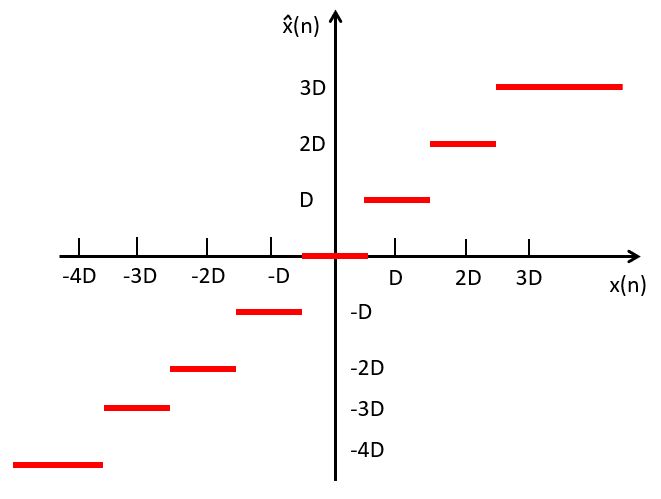
Note that a quantizer does not have to be symmetric around zero. The following shows a uniform quantizer for strictly positive values.
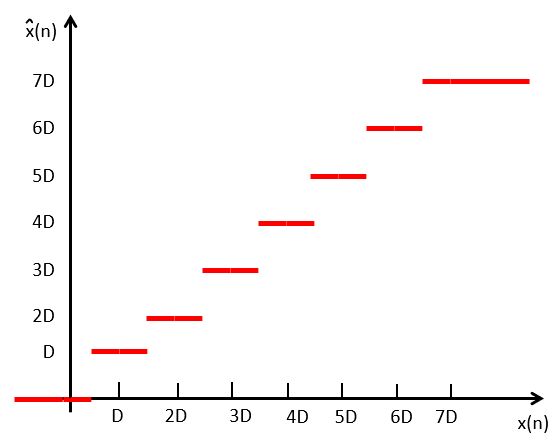
Finally, the output of the quantizer  is mapped into a set of binary code words
is mapped into a set of binary code words  .
A straightforward implementation is to generate unsigned binary code words, which increment from 000..000 for
the lowest quantization level to 111..111 for the highest quantization level.
.
A straightforward implementation is to generate unsigned binary code words, which increment from 000..000 for
the lowest quantization level to 111..111 for the highest quantization level.
Signal Sampling on the MSP432¶
The MSP432 on the lab kit contains a 14-bit successive-approximation ADC. The ADC is fully configurable from software. In the following, we summarize the operation of the ADC as used by the MSP432_BOOSTXL_LIB. Detailed information on the MSP432 ADC can be found in the MSP432 Technical Reference Manual.
First, let’s summarize the design abstraction levels that are relevant to understand the operation of sampling from a technical perspective. From the lowest abstraction level (i.e., closest to hardware) to the highest abstraction level (i.e., closest to the software application), we enumerate the abstraction levels as follows.
Hardware Schematics: The physical implementation of the MSPEXP432P401R board and the audio frontend BOOSTXL_AUDIO are each described in a user manual, the MSPEXP432P401R User Guide and the AUDIO-BOOSTXL User Guide. These user guides show the physical connections of components on the board, including the connector pin definitions as well as the schematics.
Hardware Details: Additional documentation on the hardware details of individual components on these PCB’s is captured in the datasheets for these components. For MSP432 is a fairly complex microcontroller, which has a datasheet and a low-level technical reference manual. The datasheet lists device-specific information (such as the precise configuration of pin-to-peripheral assignments), while the technical reference manual describes how to program the MSP432 peripherals.
Hardware Abstraction Library: The low-level programming on the MSP432 is handled through a separate library (aptly named DriverLib) which is part of the MSP432P401R Software Development Kit. The documentation for this library can be found through CCS Resource Explorer. It can also be downloaded as a PDF This library introduces higher level functions that simplify peripheral programming.
DSP Application Library: The make the programming of DSP applications on the MSP432 easier, we have added a software layer on top of the DriverLib. This software library, called MSP432_BOOSTXL_LIB, was developed specifically for this class, and its documentation is avalailable on the course website.
DSP Application: Finally, the application software forms the top of this stack. The application software for real-time DSP projects in this class will be written using a cyclic-executive model, ie. there is no RTOS involved.
Let’s consider these abstraction levels for the case of the loopback application of Lab 1.
Microphone Pre-amp¶
In the schematics of the AUDIO-BOOSTXL board, we find a schematic the microphone pre-amplifier:
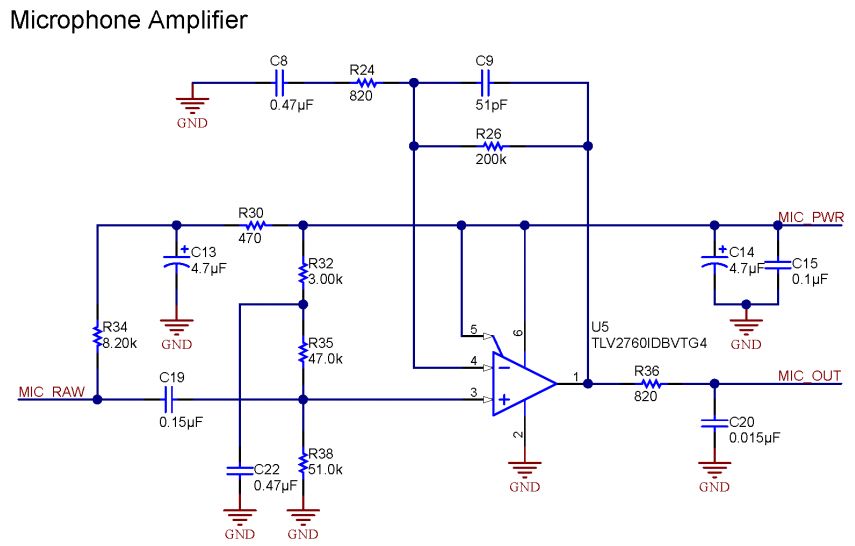
This is a non-inverting op-amp configuration with a gain of approximately 250 (200000 / 820). At the output of the pre-amplifier, there’s a first-order low-pass filter with a cut-off frequency of  . Such lowpass filters are very common before analog-to-digital conversion, as they help ensure that the analog input signal is bandwidth limited.
. Such lowpass filters are very common before analog-to-digital conversion, as they help ensure that the analog input signal is bandwidth limited.
Next, the amplified microphone signal is wired to a header pin of the AUDIO-BOOSTXL board, and from there to a corresponding header pin on the MSP432 board. To find the pin definitions of each of these headers, you have to consult the User Guide for each board. The microphone is wired to the ‘Analog In’ pin of the BoosterPack header, which in turn is connect to a pin labeled A10 RTCLK MCLK P4.3. The important piece of information is A10, which stands for ‘ADC input channel 10’. That input pin is shared with several other microcontroller functionalities (RTCLK MCLK P4.3) - which will be inactive when we use the pin as an analog input pin.
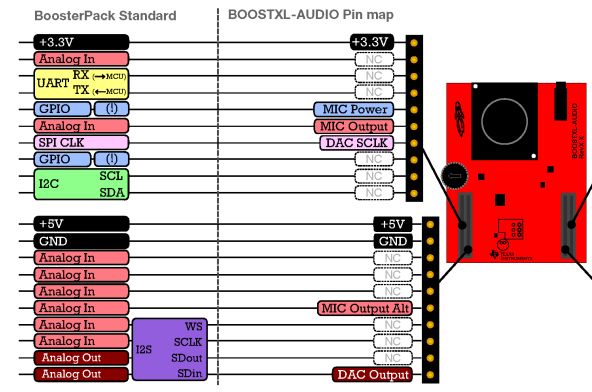
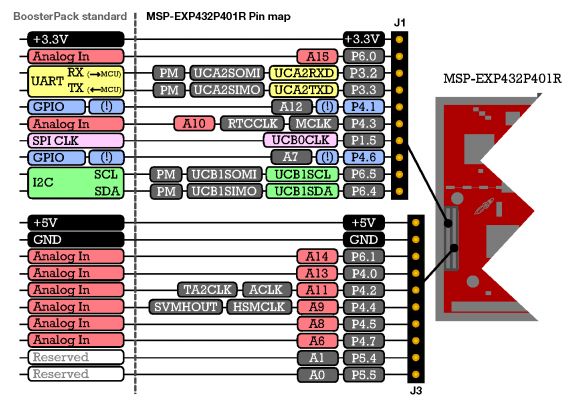
MSP432 Microcontroller¶
We are now in the MSP432 microcontroller. The MSP432 datasheet gives a summary of the (large) amount of peripherals present in this microcontroller. One of them is the ADC. Signal samples are transported over the internal data bus to an ARM Cortex-M4F processor. The ARM Cortex-M4F is a RISC micro-processor with a three-stage pipeline.
The ‘F’ suffix in ‘Cortex-M4F’ indicates that the micro-processor has a built-in floating point unit. For our DSP experiments, this is an advantage as we can write C code using floating-point numbers. While floating-point accuracy is standard (and expected) on high-end processing platforms such as your laptop, is it considered a prime feature on micro-controllers. We will come back to this aspect in one of the future lectures.
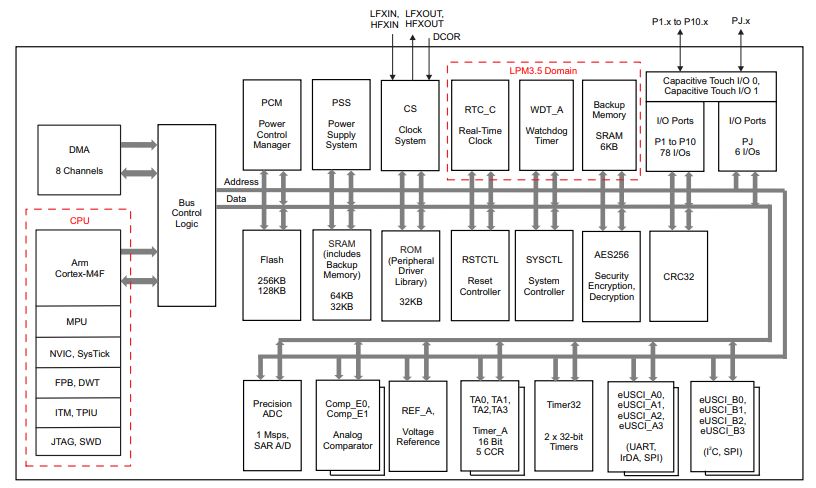
ADC14 Peripheral¶
Next, we zoom in to the ‘Precision ADC’ block and consider the internal operation. The ADC has in input multiplexer that can select between one out of 23 analog sources. The ADC has a 14-bit resolution and uses a successive approximation architecture. The sample-and-hold operation which we discussed at the start of the lecture, is at the center of the ADC. The ADC conversion is started by asserting SAMPCON. It can be asserted by software (called a ‘software trigger’), are by an external source such as a timer. When the ADC conversion finishes, the module can optionally generate an interrupt.
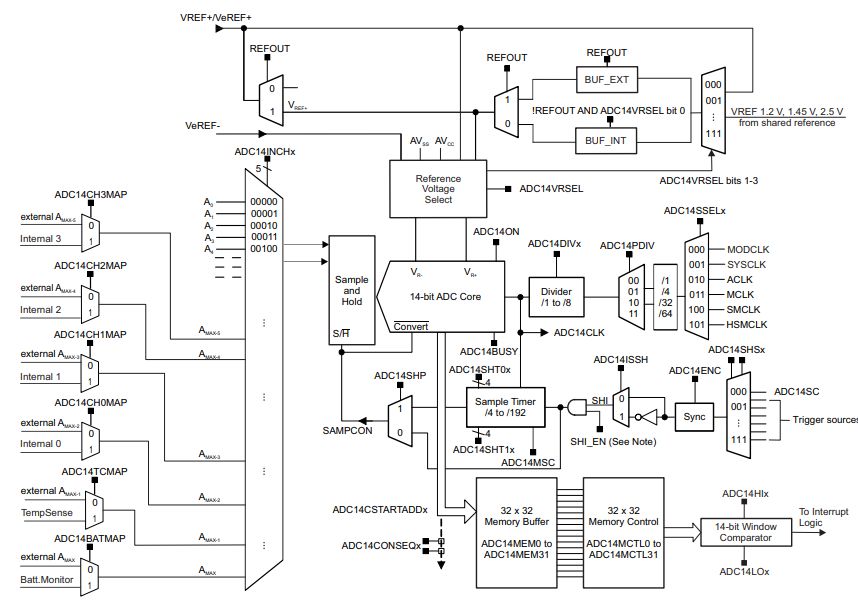
In the Lab 1 loopback example, the ADC is used as follows. A timer module will trigger a conversion at regular intervals. With the MSP432_BOOSTXL_LIB, the conversion rate can be selected between 8KHz and 48KHz. When the conversion in the ADC finishes, the ADC calls an end-of-conversion interrupt service routine (ISR). That ISR, in turn, can call a user-defined callback function. Your DSP code is integrated inside of this ISR callback function. Thus, with a conversion rate set at 16KHz, for example, your callback function is called 16,000 times per second, each time with a new converted output x.
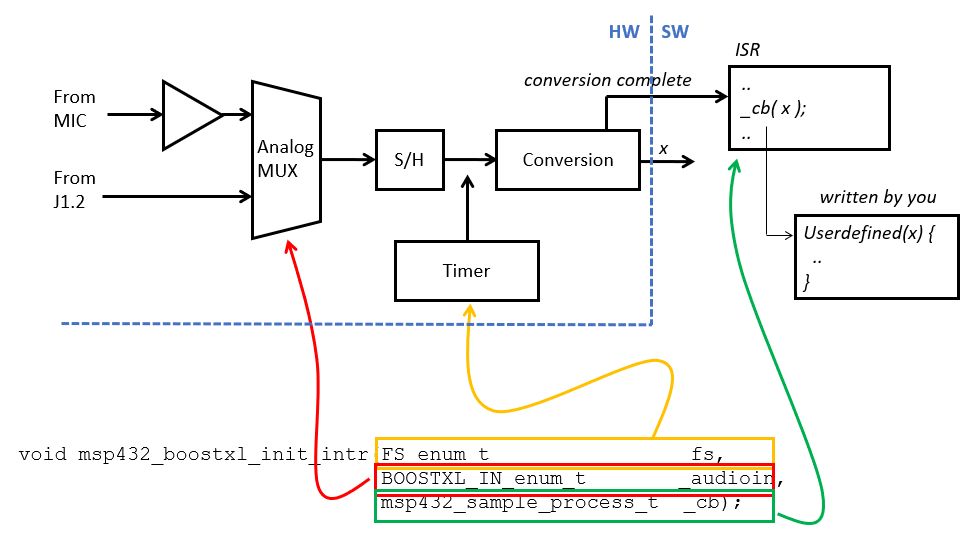
The resolution of the ADC is 14 bit. With the input voltage 0V, the output code is 0x0000. With the input voltage 3V3, the output code is 0x3FFF (that is, 14 bits all set to ‘1’). In between, the encoded value increases linearly.
Loopback Program¶
Here is the loopback program. It configures the BOOSTXL library in an interrupt-driven
mode, in which the timer will initiate the ADC conversions 16,000 times per second.
The input is taken from pin J1.2, and each time a sample is ready, it is passed
on to the function processSample. The function processSample amplifies the
signal by two and returns it. The BOOSTXL library then forwards the sample to the Digital
to Analog Converter (to be discussed in the following section).
1#include <ti/devices/msp432p4xx/driverlib/driverlib.h>
2#include "msp432_boostxl_init.h"
3#include "msp432_arm_dsp.h"
4#include <stdlib.h>
5
6uint16_t processSample(uint16_t x) {
7 return 2*x;
8}
9
10#include <stdio.h>
11
12int main(void) {
13 WDT_A_hold(WDT_A_BASE);
14
15 msp432_boostxl_init_intr(FS_16000_HZ, BOOSTXL_J1_2_IN, processSample);
16 msp432_boostxl_run();
17
18 return 1;
19}
Signal Reconstruction¶
The conversion of a discrete sequence of numbers  to a continuous-time signal
to a continuous-time signal
 is called signal reconstruction. Because of the Nyquist theorem, we know
that
is called signal reconstruction. Because of the Nyquist theorem, we know
that  can be perfectly reconstructed by a simple filter operation.
can be perfectly reconstructed by a simple filter operation.

Such a brick-wall filter is called an ideal reconstruction filter. It has an impulse response in the shape of a sinc function.

The sinc function interpolates between successive samples.  for every
value of
for every
value of  except for 0. The sinc function has a response for
except for 0. The sinc function has a response for  , which
means that it is non-causal and therefore cannot be implemented as is.
, which
means that it is non-causal and therefore cannot be implemented as is.
Here is the response of the filter on a single impulse in a stream of zero-valued samples.
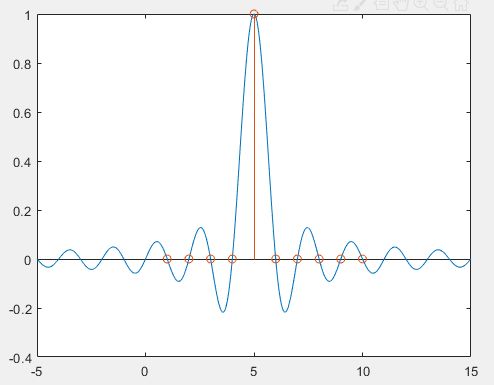
When the sample stream takes on random values, each of these random-valued pulses creates a sinc response, and all of these sinc combine to create an ideal (bandwidth-limited) interpolation of the sequence of random-valued pulses.
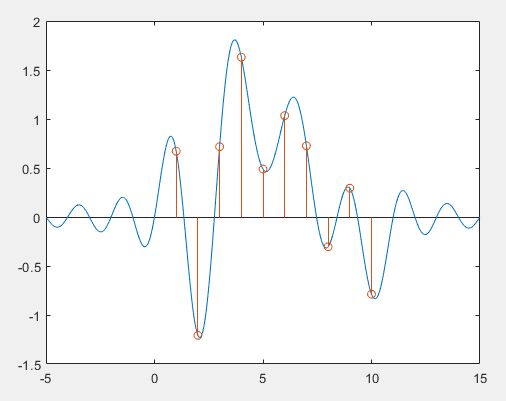
Practical Signal Reconstruction¶
Because the ideal reconstruction filter cannot be implemented, in practice it is approximated. Many Digital-to-Analog converters, including the one used in our AUDIO-BOOSTXL kit, uses a zero-order hold reconstruction. The idea of a zero-order hold is to maintain the signal level of the previous pulse until the next pulse arrives. This leads to a staircase curve:
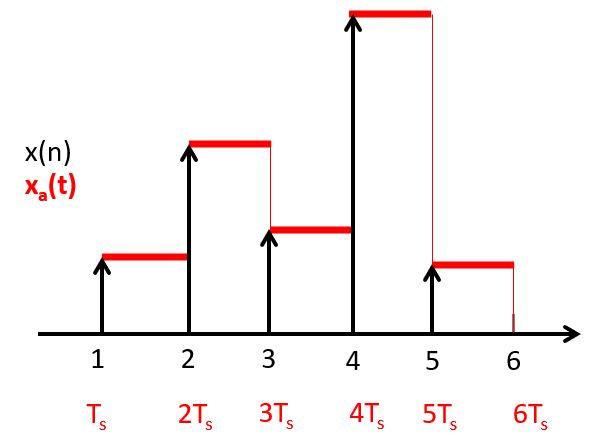
It’s useful to consider the distortion resulting from the zero-order hold reconstruction.
Clearly, the shape of the reconstructed  is quite different from the one
which was originally sampled.
is quite different from the one
which was originally sampled.
The zero-order hold reconstruction filter has an impulse reponse  :
:

This reconstruction filter has the following frequency response:

The important property of this frequency response is that it has zeroes at multiples
of the sample frequency,  . The effect of the zero-order hold filter on
the frequency response of the sampled-data signal
. The effect of the zero-order hold filter on
the frequency response of the sampled-data signal  shows the frequency
response of the imperfectly reconstructed
shows the frequency
response of the imperfectly reconstructed  .
.

Signal Reconstruction on the MSP432¶
The MSP432 does not have an on-board DAC. Instead, there is a 14-bit D/A converter on the AUDIO-XL board. This D/A converter is controller through an SPI interface on the MSP432, in addition to a SYNC pin.
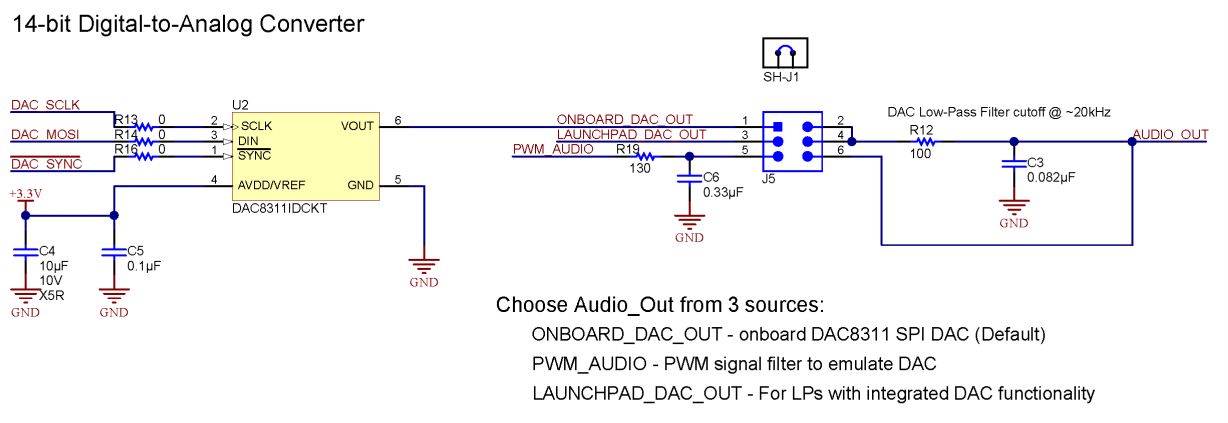
We first discuss the implementation on the AUDIOXL board, and next discuss the SPI
interface between the MSP432 and the AUDIO-XL board. The DAC is driven through a serial
SPI interface. The DAC has a zero-order hold response, and this response can be observed
by connecting an oscilloscope probe to pin 2 or pin 4 of connector J5. However, the signal
that is driving the audio amplifier is passed through a lowpass filter with a cutoff frequency
of approximately  . This means that the sincx
effect of the staircase reconstruction may roll off quicker at higher frequencies. However,
when you generate signals with a sample frequency below 20KHz, you should be able to
observe parts of the sampled-data spectrum
. This means that the sincx
effect of the staircase reconstruction may roll off quicker at higher frequencies. However,
when you generate signals with a sample frequency below 20KHz, you should be able to
observe parts of the sampled-data spectrum  beyond the Nyquist frequency.
beyond the Nyquist frequency.
Note
In high-end audio systems, a signal construction filter would be much more sophisticated; it would eliminate any frequency beyond the Nyquist frequency, and it would eliminate the amplitude distortion caused by zero-order hold below the Nyquist frequency. The simplicity of the signal reconstruction hardware on our lab kit allows you to investigate the consequences of ‘imperfect’ signal reconstruction.
DAC8311 Chip¶
Next, we discuss the communication between the MSP432 and the DAC chip. The SPI interface communicates one byte at a time, so 14 bits for the DAC are transferred using a high byte and a low byte. The DAC has a SYNC pin which is asserted to indicate when the first byte is transmitted. The bits are transmitted MSB to LSB, and the DAC datasheet (DAC8311) illustrates the timing.

The MSP432_BOOSTXL library includes a software function, DAC8311_updateDacOut(uint16_t value),
which writes a new value to the DAC:
1void DAC8311_updateDacOut(uint16_t value) {
2 // Set DB15 and DB14 to be 0 for normal mode
3 value &= ~(0xC000);
4
5 DAC8311_writeRegister(value);
6}
7
8static void DAC8311_writeRegister(uint16_t data) {
9 // Falling edge on SYNC to trigger DAC
10 GPIO_setOutputLowOnPin(DAC8311_SYNC_PORT,
11 DAC8311_SYNC_PIN);
12
13 while (EUSCI_B_SPI_isBusy(DAC8311_EUSCI_BASE)) ;
14 EUSCI_B_SPI_transmitData(DAC8311_EUSCI_BASE, data >> 8); // high byte
15
16 while (EUSCI_B_SPI_isBusy(DAC8311_EUSCI_BASE)) ;
17 EUSCI_B_SPI_transmitData(DAC8311_EUSCI_BASE, data); // low byte
18
19 while (EUSCI_B_SPI_isBusy(DAC8311_EUSCI_BASE)) ;
20
21 // Set SYNC back high
22 GPIO_setOutputHighOnPin(DAC8311_SYNC_PORT,
23 DAC8311_SYNC_PIN);
24}
Distortion in the Sampling and Reconstruction Process¶
Finally, we summarize the sources of distortion in the sampling and reconstruction process. We can now understand the causes and effect of each type of distortion.
1. Aliasing is caused when a continuous-time signal is sampled at a rate below twice the highest frequency component in that continuous-time signal. Aliasing causes overlap between adjacent frequency bands in the discrete-time signal, and it causes non-recoverable distortion.
2. Quantization Noise is caused because the disrete-time signal is quantized on a finite number of quantization steps. Quantization noise is a non-linear effect, and its effect is often modeled as additive noise. We will investigate quantization noise in more detail when we discuss filters.
3. Jitter is caused by imperfect sampling, and is visible by random shifts back and forth in time. Jitter is a non-linear effect as well, and eventually appears as noise in the reconstructed signal.
Zero-order Hold is an effect in the signal reconstruction process where imperfect reconstruction is used instead of ideal sinc interpolation. A zero-order hold is a linear (filter) effect, which can be compensated by proper reconstruction filter design.
Demonstration¶
Loopback application
Sample and reconstruct
Look at the spectrum